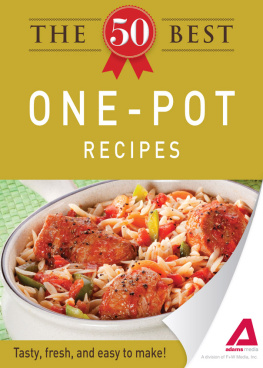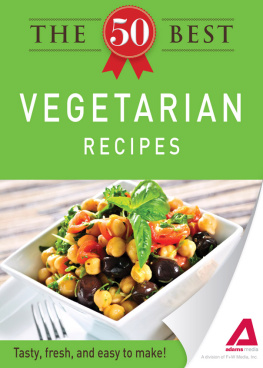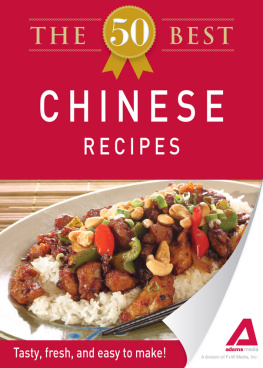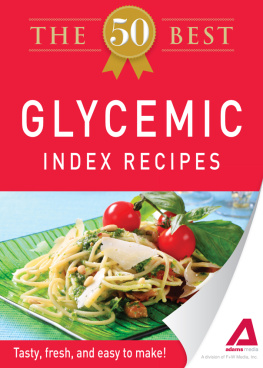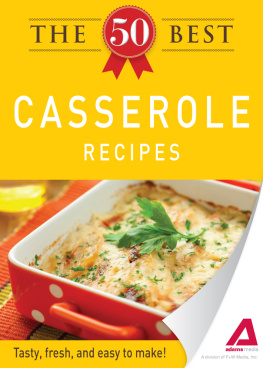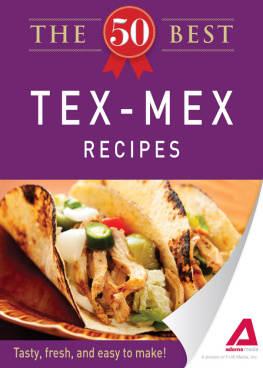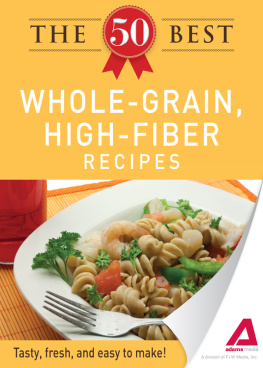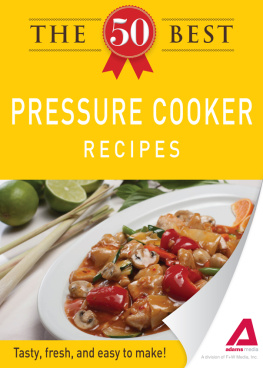
The 50 Best
Rice Cooker Recipes
Tasty, fresh, and easy to make!
Adams Media, a division of F+W Media, Inc.

Avon, Massachusetts
Contents
Introduction
The rice cooker was considered a kitchen revolution when it was invented in Japan in the 1950s as it changed the lives of many homemakers in that country, where cooking rice in traditional ways was time-consuming.
How versatile is the rice cooker? You can steam, stew, stir-fry, braise, saut almost like a portable stovetop! You can cook in the rice cooker the same way you cook with a pan on the stove, since the rice cooker can generate its own heat. Many of your daily recipes can be easily adapted to rice cookers. In fact, much home cooking is gradually moving away from the rigidity of traditional recipes and advocating improvisational cooking as an even quicker and easier way to make everyday meals.
Building on successful meals is not difficult as long as the dishes can be deconstructed into basics: ingredients, taste, balance, flavors, and the correct techniques. Similarly, rice cooker cooking also starts with building a foundation the correct technique; then you can make changes by experimenting. Such little experiments in each recipe will allow you to learn new flavors every day, and hopefully allow you to improvise and be creative in the process of working with your new tool.
For those who already own a rice cooker and are already using it, mainly to cook rice and simple dishes, there is a much larger variety of recipes to explore, from nourishing soups to hearty meals. For those who do not yet own a rice cooker and are thinking of getting one, this can be a good starter guide on how to use the rice cooker for these fifty simple and appetizing recipes. Bon apptit!
Basic Long-Grain White Rice
While brown rice is cooked with a 2 : 1 water to rice ratio, long grain white rice water to rice ratio is less 1.5 : 1. For best results, use cold water and unplug your cooker while you let the rice rest for a few minutes at the end.
Serves 2

Ingredients
1 cup long-grain white rice
1 cups water
Rinse rice well by gently swirling the rice in the rice cooker pot with 2 or 3 changes of cold water. Drain rice.
Add the 1 cups water to the cooker pot. The water should cover the rice by about inch. Place the pot back into the rice cooker, cover, and set to Cook. Time to cook varies with the type of rice cooker used.
After rice is cooked, do not open the cover immediately. Let it sit for 5 to 10 minutes to vent off the remaining steam. Fluff up the rice before serving.
Rice Rinsing
When rinsing rice, gently swirl the rice in the pot with 2 or 3 changes of water, draining off the water each time. It is not necessary to rinse until the water is completely clear, as nutrients may be lost in the rinsing process.
Rice Congee
A common breakfast porridge enjoyed in many Asian countries, congee is more forgiving when it comes to how much water you use. Adjust according to whether you prefer a thicker or thinner cereal.
Serves 2

Ingredients
1 cup long-grain white rice
3 to 4 cups water, according to desired consistency
Rinse rice well by gently swirling the rice in the cooker pot with 2 or 3 changes of cold water. Drain rice.
Add 3 to 4 cups water to the pot, cover, and set to Cook. When you hear the rice cooker making noises and see over-bubbling of fluid at the lid, lift up the rice cooker cover, stir the congee, and continue to cook for about 15 minutes with rice cooker lid tilted slightly to vent the steam pressure.
Continue cooking and adjust water amount depending on whether you prefer thick or soupy rice congee.
Mix Up Your Grains
You can use different rice grains (red, brown, and white) when cooking rice or rice congee to introduce different flavors and texture. However, cooking two or more kinds of rice grains together can be challenging, as they will require different amounts of water and different cooking times. Combining grains is easier when making rice congee, because the proportions of rice and water are not as strict as they are for cooking rice used in other dishes.
Salmon Pancakes
Put your rice cooker to use making dishes other than rice, like these savory dinner pancakes. You can use leftover fresh-cooked salmon in lieu of canned if you have it.
Serves 4 as a side dish

Ingredients
1 egg, lightly whisked
2 (6-ounce) cans salmon, flaked
cup finely chopped cilantro leaves
Salt and freshly ground black pepper, to taste
2 tablespoons vegetable oil
4 small lemon wedges
Stir half of the whisked egg into the salmon, add cilantro, and mix well. Continue to add remaining egg to mixture and mix well until the egg is absorbed by the salmon and the mixture can be formed into firm patties. Season with salt and pepper.
Add oil to the rice cooker, cover, and set to Cook.
When the base of the cooker pot gets warm, form flat patties (about 1-inch diameter) from the mixture and add to the rice cooker. Pan-fry the patties (about 2 to 3 minutes per side), until their surface turns brown and slightly crisp, making sure to cover the rice cooker while frying. Serve with squeeze of lemon.
Todays Dinner Can Be Tomorrows Lunch
Grilled fish leftovers tend to become dry under subsequent reheating. If you had grilled fish leftovers from the night before, you can break the leftover fish into flakes for use in these patties.
Chicken Satay Skewers
Heres a popular Southeast Asian dish normally served with a peanut dipping sauce. Make your own sauce by combining 2 parts creamy peanut butter, 1 part coconut milk, a dash of soy sauce, and red pepper flakes, and mixing until smooth.
Yields about 16-20 mini-skewers

Ingredients
2 teaspoons curry power
1 teaspoon turmeric
teaspoon salt
1 teaspoon brown sugar
teaspoon grated garlic
1 teaspoon grated fresh ginger
3 to 4 tablespoons vegetable oil, divided use
2 boneless chicken thighs, cut into 2-inch long -inch thick strips
Combine curry powder, turmeric, salt, brown sugar, garlic, ginger, and 1 tablespoon of the oil in a gallon-size plastic food bag. Add the chicken pieces, seal the bag, and turn the bag a few times to make sure the chicken pieces are coated with the marinade. Refrigerate and allow to marinate for 2 hours.
Thread the chicken pieces onto short skewers (about 4 inches long, or a length that can fit the diameter of your rice cooker).
Add remaining oil into the rice cooker, cover, and set to Cook. When the base of the cooker pot gets warm, add the skewered chicken (work in batches) and pan-fry the chicken for about 5 minutes on each side until browned and cooked through, being sure to cover the rice cooker while pan-frying. Use kitchen tongs to help hold the skewers and turn the chicken over, if necessary.
Dinner Is Served
Pan-frying the satay is an alternative cooking method for people who do not own an outdoor grill and do not like to deal with the mess of charcoal and smoke. Serve the satay with sliced red onions, sliced cucumbers, rice cakes (also known as ketupat), and your favorite peanut sauce.
Next page





